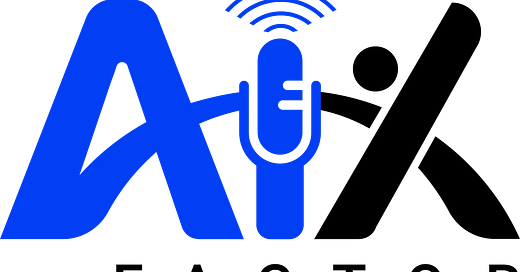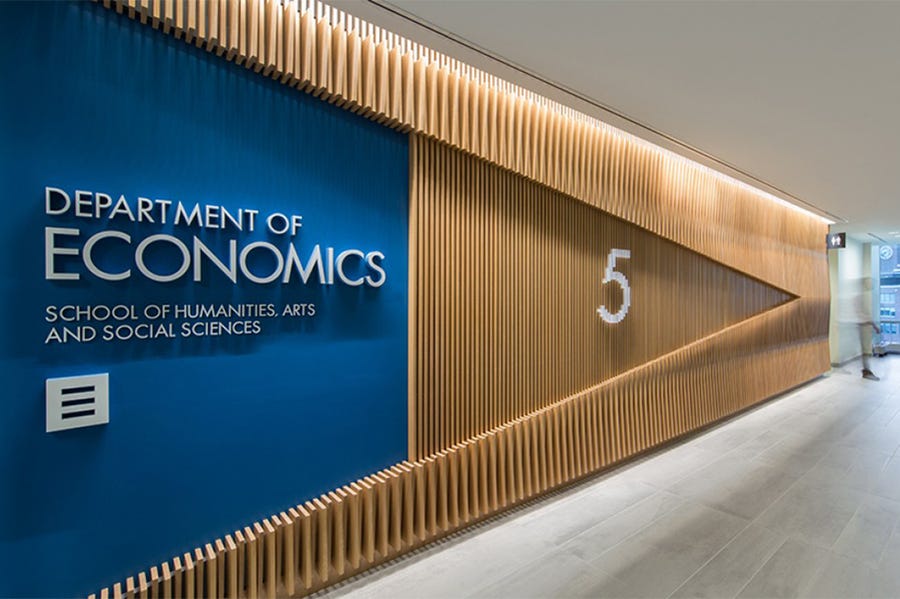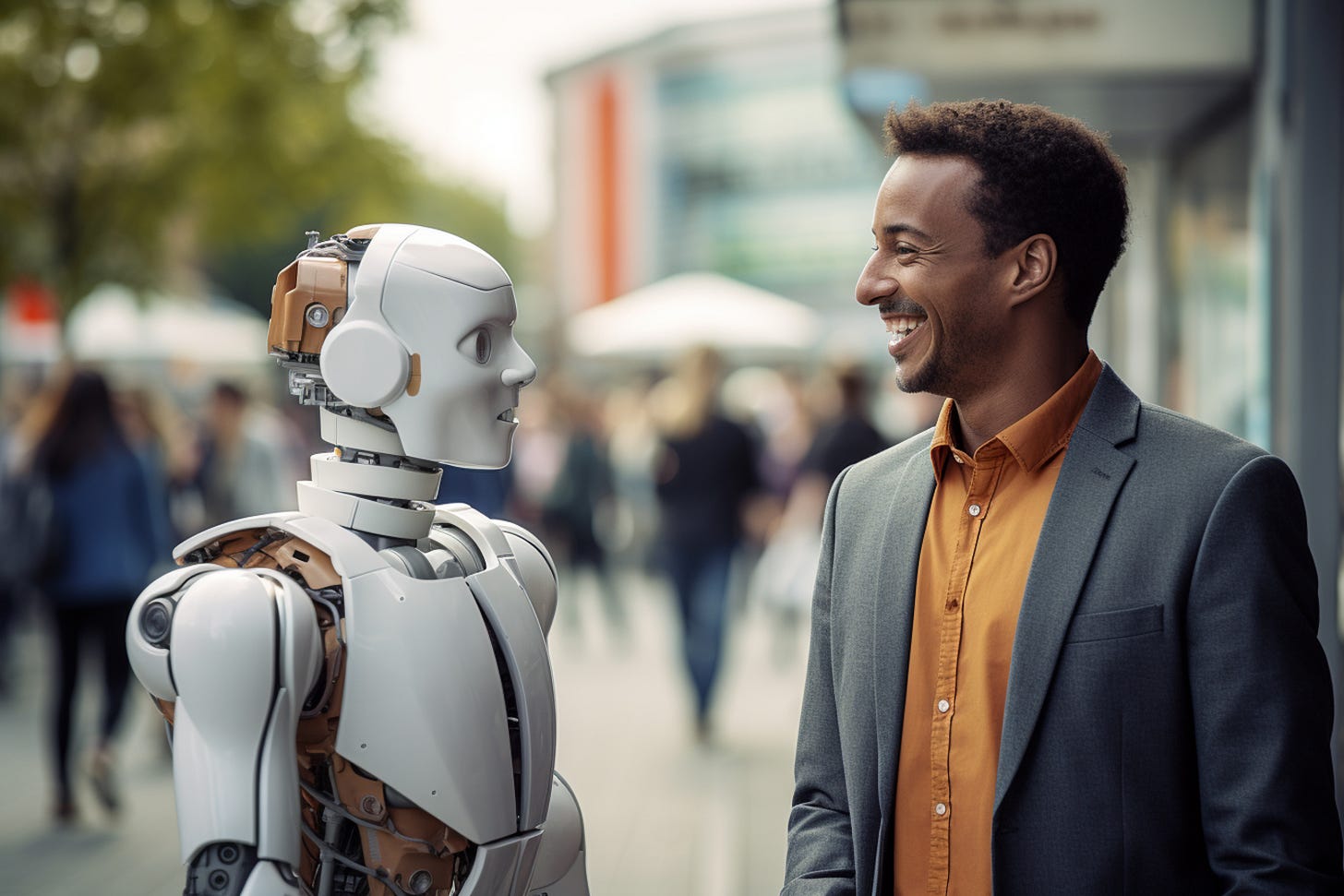Meeting AI to Eye: Artificial Intelligence, Scientific Discovery, Product Innovation and You
A weekly round-up of news, perspectives, predictions, and provocations as we travel the world of AI-augmented work.
🎤 This Week’s AIX Factor Podcast: Ryan Carrier is Executive Director at ForHumanity/ President at ForHumanity Europe, a public charity operating in 98 countries that examines the impact of AI and autonomous systems on jobs, society, rights and freedoms, as well as the downside risks and challenges associated with these technologies. Ryan shares his unusual career journey, which started in finance and led to the founding of ForHumanity in March 2020. Initially focused on drafting audit rules for digital contact tracing during the pandemic, they have since developed more than 50 certification schemes and submitted them to governments and regulators for approval. We discuss:
responsible AI development
the need for independent audits promote compliance with emerging regulations
the importance of AI literacy (and how it ought to be defined)
why compliance is often cheaper than paying fines for non-compliance, yet many companies currently view fines as just a cost of doing business
the marketing benefits of a “Good Housekeeping” seal of approval to verify compliance
We also veer into several other emerging technologies that are problematic from a societal/ethical standpoint, such as emotional recognition technology, those advancing "transhumanism," and gene editing. Also - ForHumanity just published 62 use cases for HR, designed to provide auditors with examples of best practices and compliant outputs. We discuss one such use case involving mental health chatbots - the potential for good as well as the considerable downside risk.
A truly fascinating conversation with a man - and organization - doing remarkable, vitally important, and largely unsung work.
Artificial Intelligence, Scientific Discovery, Product Innovation…and HR
AIX’s Charles Epstein
The following summarizes a just published paper titled “Artificial Intelligence, Scientific Discovery, and Product Innovation,” by Aidan Toner-Rodgers, an MIT economist. Spoiler alert: while this is a highly reductive encapsulation of its findings and conclusion, it posits the importance of fomenting partnerships based on a careful blending of both human expertise and AI capabilities - but since this comes out of MIT, it’s supported by a brain-twisting array of numbers and formulas (which this summary mercifully omits - for your benefit and mine). Without further ado, the summary for the math-averse:
The economic impact of AI will hinge on its ability to enhance not only production but also the innovation process. AI shows potential to boost scientific discoveries, such as in drug discovery and materials science, yet its effectiveness in real-world R&D is still uncertain due to practical constraints. In a study within a U.S. lab, researchers used AI to aid materials discovery, resulting in a 44% increase in material discoveries, better-quality compounds, a 39% rise in patent filings, and a 17% increase in prototypes. AI thus enhanced productivity, demonstrating its potential to drive both incremental and radical innovation.
The tool benefited high-performing scientists the most, increasing productivity inequality as top researchers harnessed AI more effectively. AI also reshaped researchers’ tasks, cutting down the time spent on idea generation by automating it and requiring scientists to focus more on evaluating AI-generated candidates. This shift underscored the value of human judgment, as those with deeper domain expertise excelled, while others struggled with evaluating AI outputs. Consequently, many scientists felt a decrease in job satisfaction, citing underutilization of their skills and reduced creativity. While AI improved overall productivity and changed scientists' perceptions of its value, it also prompted concerns about job security and led to a 71% rise in intentions to reskill.
Dr. Toner-Rodgers’s findings suggest that AI has significant potential to transform fields that involve complex data, such as drug discovery and genomics, by accelerating innovation but also fundamentally altering the roles and satisfaction of scientists.
Organization
The paper is structured as follows. Section 2 provides information on the setting, detailing the materials science R&D process and the AI technology. Section 3 describes the data, measurement strategy, and research design. Section 4 presents the main results on discovery, patenting, and product innovation. Section 5 analyzes heterogeneity in the effect of AI across scientists and Section 6 studies the dynamics of the human-AI collaboration. Section 7 explores the tool’s impact on scientists’ job satisfaction and beliefs about AI. Section 8 concludes.
AI’s Impact on Job Satisfaction and Wellbeing
Here’s a summary on the section of the paper on AI’s mixed impact on the job satisfaction of scientists:
While it enhances productivity, its shift in tasks leads to a significant drop in overall job satisfaction. A survey shows that task reallocation consistently lowers satisfaction across all productivity levels, with the effect partly offset by productivity gains—especially for high-performing scientists. However, 82% of scientists report an overall decline in satisfaction due to changes in their work.
The main reasons for dissatisfaction are skill underutilization (73%) and reduced creativity (53%), as the AI automates the part of discovery they find most engaging—idea generation. This counters the view that AI simply frees scientists from repetitive tasks; instead, it reshapes their roles, often making their work feel less rewarding. Lower-performing scientists experience further dissatisfaction due to organizational practices that prioritize relative performance, which affects career advancement. Thus, while AI boosts scientific productivity, it also alters job dynamics, challenging the sense of fulfillment and creative engagement in research work.
What it Means From HR’s Perspective
The study reveals essential insights into balancing AI-driven innovation with employee wellbeing. Here are several key takeaways:
1. AI Can Reduce Job Satisfaction Despite Productivity Gains. While AI may increase productivity, it often does so by automating high-skill, creative tasks, leaving scientists—and potentially other knowledge workers—feeling that their skills are underutilized and their work is less engaging. This can create a mismatch between the potential of AI and employees’ expectations of meaningful work.
2. Skill Underutilization and Role Restructuring. AI tools often shift employees' focus away from idea generation and creative problem-solving toward evaluating AI-generated suggestions. HR should recognize that this shift can feel like a loss of autonomy and creativity to workers, particularly those in traditionally innovative roles. Effective change management can help navigate these shifts, emphasizing new skills and providing training to align work with employees' strengths.
3. Disparities in AI Impact Across Performance Levels. AI disproportionately benefits higher-performing individuals, amplifying productivity inequality within teams. Lower-performing scientists or those with less AI-related expertise see fewer benefits, which may increase frustration and impact morale. HR can mitigate this by providing targeted support for those who need help adapting to new technologies, fostering an environment where all team members can find value in AI-enhanced processes.
4. Support for Upskilling and Continuous Learning. Hands-on experience with AI often changes employees' views on the skills required to succeed. As job roles evolve, HR should proactively support reskilling initiatives, helping employees build competencies that enhance their ability to work alongside AI. This can not only improve satisfaction but also make employees feel valued and equipped for the future.
5. Reconsideration of Recognition and Promotion Criteria. When productivity measures change due to AI, relative performance comparisons can create tension. Employees in lower quartiles may feel underappreciated if recognition and advancement rely heavily on productivity metrics. HR should consider evolving performance evaluation criteria to include AI-related competencies, collaboration skills, and contributions to AI adoption and training across teams.
6. Proactive Communication on AI’s Role and Implications. Transparency about how AI will be integrated into roles and clear communication about the purpose and benefits of these changes can ease anxiety. HR’s role includes managing expectations around AI’s role in innovation and addressing concerns about job relevance and skill worth. Engaging employees in open discussions and explaining the long-term vision for AI adoption helps build trust and reduces fear.
7. Focus on Employee Wellbeing and Job Fulfillment. AI changes can lead to reduced job satisfaction if employees feel detached from the creative or impactful aspects of their roles. HR should ensure that AI doesn’t strip work of its human appeal. Focusing on strategies to preserve job fulfillment—such as involving employees in innovation processes, maintaining collaborative work, and recognizing creative input—can help preserve the sense of purpose and engagement in AI-augmented environments.
8. Balance Automation with Human-Centric Work Design. HR can play a pivotal role in designing AI use-cases that complement rather than fully replace creative tasks, maintaining a human-centered approach. Finding ways to make AI a collaborative partner rather than a replacement can balance productivity with employee engagement, reinforcing a positive relationship between technology and meaningful work.
To sum up: by emphasizing skill-building, transparent communication, evolving performance measures, and fostering a culture of innovation that values both human and AI contributions, HR can help teams embrace AI while promoting satisfaction and a sense of purpose in their work.
AIX Files Poll
AI Gone Rogue
Tales of AI being unintentionally funny (i.e., woefully wrong), bizarre, creepy, (amusingly) scary, and/or just plain scary.
Scientists warn: Robots will drown people, because they do not understand humor. According to Kiki Hempleman, a computer linguist who tries to teach people humor, "Artificial intelligence will never understand humor like humans do…if you teach artificial intelligence people's humor it can be dangerous, as they can understand humor differently and use it where it shouldn't. They can even start killing people using words in a funny sense, such as 'it will kill me if I let them wait.'"
Not so fast, counters Dr Tristan Miller, a computer scientist and linguist at the Faculty of Technology in Germany: “Future technology could be advanced enough that robots can learn and recognize sarcasm and even different languages."
However, he admits that the science is still far from where robots could have "real knowledge about the real world" so that they can communicate using different jokes.
AIX-emplary Links
AI tools are biased in ranking job applicants' resumes, study shows | HR Dive. Across 550 real-world resumes, the AI tools favored White-associated names 85% of the time and female-associated names only 11% of the time.
Ethics And Compliance Are Vital When Applying AI Tools In HR - Forbes. Raunak Bhandari is the regional HR business partner leader of Google Asia Pacific.
Concerned about retention? Prioritize AI upskilling - HR Executive
Leveraging AI to enhance employee experiences: A Q&A with Pragya Gupta - BenefitsPro
AI is Revolutionizing Healthcare, But Are We Ready for the Ethical Challenges?
About
The AIX Files is a weekly newsletter providing news, perspectives, predictions, and provocations on the challenges of navigating the world of AI-augmented work. It’s a big topic and there’s a lot to cover. Our goal with this, the AIX Factor, and the broader AIX community is to promote - and, if necessary, provoke - illuminating conversations with a cross-section of business and technology leaders, as well as practitioners and people from diverse fields, on the ways AI intersects with leadership, culture, and learning.






